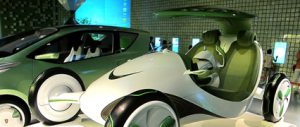Poor sales of electric vehicles (EV) in the US and China have led to serious questions about their viability. Despite Chinese government incentives, only a few Chinese EV pilot cities have met their target of putting 1,000 EVs on the road. Meanwhile, in the US sales targets for two high profile products, the GM Volt and Nissan Leaf, were also missed by wide margins in 2012. Even the good news from Tesla Motors of a profitable first quarter in 2013 was overshadowed by the gloom of a series of bankruptcies including Fisker Automotive, battery-manufacturer A123 Systems, and electric car company Better Place.
There is room for optimism, however, as the US-China Working Group on Climate Change reconfirmed their joint efforts to develop clean fuel for transportation at the Fifth Strategic and Economic Dialogue this July. And before declaring that EVs are a sinking ship, it’s worth considering the development of the first commercial car. Its own journey was by no means smooth. After the first three-wheeled Benz Motorwagen appeared in 1885, only 25 were sold in the next five years.
Early cars also had their own share of problems. The internal combustion engine was unstable and even exploded in several notable incidents. Safety was a big concern as seat belts, four-wheel brakes and windshields didn’t appear in cars until much later. There was also no established network of gas stations which limited the travel range. As a result, the car was widely regarded as purely an urban vehice.
The Ford car example
The breakthrough came in 1913 when Henry Ford incorporated the assembly line and interchangeable parts into the Ford car manufacturing process. Ford’s cars were soon coming off the assembly line at fifteen-minute intervals. The increase in production volume lowered the cost, making it so affordable that an assembly line worker could afford a Ford Model T with four months’ pay. This set off the explosive growth of car use; over the past century the US has added an average of more than one million cars to the road every year.
With the explosion of demand for cars, technology quickly continued to improve as well. Increased demand also fostered the development of strong social and technological elements to support this growth such as better road infrastructure, regulations, cultural enthusiasm for cars and improved user experiences.
It is striking how many of the barriers that the EV encounters today are similar to those faced by the car about a century ago. These include restricted travel range, safety concerns, mechanical difficulties, and a lack of infrastructure. The transition to EV use, if and when it comes, stands to be even quicker than that to cars. In 2011 and 2012, the US saw about 70,000 new EVs on the road. EVs and hybrids combined made up 3% of the US’ total car sales in 2012. New EV models are also gaining popularity in China and Europe. Globally, the number of charging stations is growing much more quickly than the gas station network thanks to government support.
EVs still need a more extensive charging station network. Better battery technology and a lower price will both be vital. EVs are currently exclusive to the rich – like the early automobile. The technological equivalent of the “assembly line” breakthrough – where volume resulted in increased profit and a lower price in the car industry – has yet to come for EVs.
It is the nature of “disruptive innovation” that one can hardly predict where and when the most crucial piece of the EV innovation jigsaw will come. Governments with great EV ambitions like the US and China need to moderate their expectations and allow more time for technological breakthroughs to drive the transition to EVs. In the meantime, they should focus on developing policies that create the necessary infrastructure and business environment to facilitate this shift.
As the assembly line demonstrated at the turn of the last century, new markets do not abide by mandates. Similarly, disrupting the gigantic infrastructure that has developed around the internal combustion engine will require ingenuity and persistence.
This article was originally published in Scientific American






